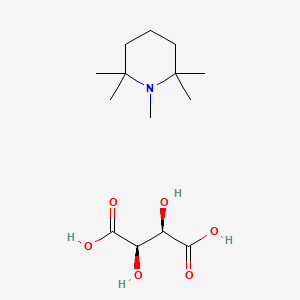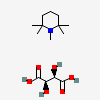Pempidine tartrate
- Pempidine tartrate
- 546-48-5
- Pempidine hydrogen tartrate
- Tensoral
- 1,2,2,6,6-Pentamethylpiperidine tartrate
- Create:2005-08-08
- Modify:2025-01-04

- Pempidine tartrate
- 546-48-5
- Pempidine hydrogen tartrate
- Tensoral
- 1,2,2,6,6-Pentamethylpiperidine tartrate
- THI82M7N4M
- Sinapleg
- Synapleg
- (2R,3R)-2,3-dihydroxybutanedioic acid;1,2,2,6,6-pentamethylpiperidine
- Pempidine bitartrate
- Pempidina tartrato
- Piperidine, 1,2,2,6,6-pentamethyl-, (2R,3R)-2,3-dihydroxybutanedioate (1:1)
- Pempidina tartrato [Italian]
- EINECS 208-902-8
- UNII-THI82M7N4M
- PEMPIDIL
- PEMPITEN
- TENSINOL
- Piperidine, 1,2,2,6,6-pentamethyl-, (R-(R*,R*))-2,3-dihydroxybutanedioate (1:1)
- Lopac0_000939
- SCHEMBL933339
- PEMPIDINE TARTRATE [MI]
- Piperidine, 1,2,2,6,6-pentamethyl-, tartrate (1:1)
- AAFNEINEQRQMTF-LREBCSMRSA-N
- PEMPIDINE TARTRATE [WHO-DD]
- NCGC00094245-01
- M&B-4486
- EU-0100939
- M & B 4486
- P 5114
- SR-01000076249
- SR-01000076249-1
- Q27289971
- 1,2,2,6,6-pentamethylpiperidine (2R,3R)-2,3-dihydroxysuccinate

P264, P270, P301+P316, P321, P330, P405, and P501
(The corresponding statement to each P-code can be found at the GHS Classification page.)
Aggregated GHS information provided per 38 reports by companies from 1 notifications to the ECHA C&L Inventory.
Information may vary between notifications depending on impurities, additives, and other factors. The percentage value in parenthesis indicates the notified classification ratio from companies that provide hazard codes. Only hazard codes with percentage values above 10% are shown.
IMAP assessments - Piperidine, 1,2,2,6,6-pentamethyl-, 2,3-dihydroxybutanedioate (1:1), [R-(R*,R*)]-: Environment tier I assessment
IMAP assessments - Piperidine, 1,2,2,6,6-pentamethyl-, 2,3-dihydroxybutanedioate (1:1), [R-(R*,R*)]-: Human health tier I assessment
Patents are available for this chemical structure:
https://patentscope.wipo.int/search/en/result.jsf?inchikey=AAFNEINEQRQMTF-LREBCSMRSA-N
- Australian Industrial Chemicals Introduction Scheme (AICIS)Piperidine, 1,2,2,6,6-pentamethyl-, 2,3-dihydroxybutanedioate (1:1), [R-(R*,R*)]-https://services.industrialchemicals.gov.au/search-assessments/
- CAS Common ChemistryLICENSEThe data from CAS Common Chemistry is provided under a CC-BY-NC 4.0 license, unless otherwise stated.https://creativecommons.org/licenses/by-nc/4.0/Piperidine, 1,2,2,6,6-pentamethyl-, (2R,3R)-2,3-dihydroxybutanedioate (1:1)https://commonchemistry.cas.org/detail?cas_rn=546-48-5
- ChemIDplusChemIDplus Chemical Information Classificationhttps://pubchem.ncbi.nlm.nih.gov/source/ChemIDplus
- European Chemicals Agency (ECHA)LICENSEUse of the information, documents and data from the ECHA website is subject to the terms and conditions of this Legal Notice, and subject to other binding limitations provided for under applicable law, the information, documents and data made available on the ECHA website may be reproduced, distributed and/or used, totally or in part, for non-commercial purposes provided that ECHA is acknowledged as the source: "Source: European Chemicals Agency, http://echa.europa.eu/". Such acknowledgement must be included in each copy of the material. ECHA permits and encourages organisations and individuals to create links to the ECHA website under the following cumulative conditions: Links can only be made to webpages that provide a link to the Legal Notice page.https://echa.europa.eu/web/guest/legal-noticePempidine hydrogen tartratehttps://echa.europa.eu/substance-information/-/substanceinfo/100.008.094Pempidine hydrogen tartrate (EC: 208-902-8)https://echa.europa.eu/information-on-chemicals/cl-inventory-database/-/discli/details/44678
- FDA Global Substance Registration System (GSRS)LICENSEUnless otherwise noted, the contents of the FDA website (www.fda.gov), both text and graphics, are not copyrighted. They are in the public domain and may be republished, reprinted and otherwise used freely by anyone without the need to obtain permission from FDA. Credit to the U.S. Food and Drug Administration as the source is appreciated but not required.https://www.fda.gov/about-fda/about-website/website-policies#linkingPEMPIDINE TARTRATEhttps://gsrs.ncats.nih.gov/ginas/app/beta/substances/THI82M7N4M
- CCSbaseCCSbase Classificationhttps://ccsbase.net/
- Springer Nature
- Wikidatapempidine tartratehttps://www.wikidata.org/wiki/Q27289971
- PubChem
- GHS Classification (UNECE)GHS Classification Treehttp://www.unece.org/trans/danger/publi/ghs/ghs_welcome_e.html
- NORMAN Suspect List ExchangeLICENSEData: CC-BY 4.0; Code (hosted by ECI, LCSB): Artistic-2.0https://creativecommons.org/licenses/by/4.0/NORMAN Suspect List Exchange Classificationhttps://www.norman-network.com/nds/SLE/
- MolGenieMolGenie Organic Chemistry Ontologyhttps://github.com/MolGenie/ontology/
- PATENTSCOPE (WIPO)SID 391622672https://pubchem.ncbi.nlm.nih.gov/substance/391622672

 CID 444305 (L-Tartaric acid)
CID 444305 (L-Tartaric acid) CID 6603 (Pempidine)
CID 6603 (Pempidine)